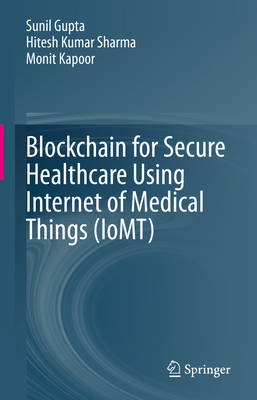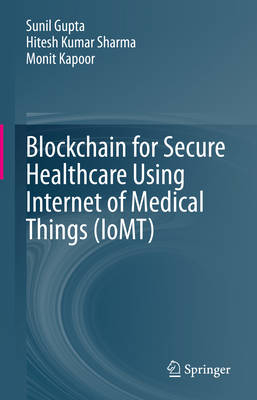
- Retrait gratuit dans votre magasin Club
- 7.000.000 titres dans notre catalogue
- Payer en toute sécurité
- Toujours un magasin près de chez vous
- Retrait gratuit dans votre magasin Club
- 7.000.0000 titres dans notre catalogue
- Payer en toute sécurité
- Toujours un magasin près de chez vous
Blockchain for Secure Healthcare Using Internet of Medical Things (Iomt)
Sunil Gupta, Hitesh Kumar Sharma, Monit KapoorDescription
1.1. Introduction
1.2. Smart Healthcare and Telemedical System
1.2.1. Smart Healthcare Technology
1.2.2. Remote monitoring and automated healthcare system
1.2.3. Remote Care and Telehealth
1.2.4. Emergency response solution for connectivity
1.2.5. Smart Hospital Management
1.3. Telemedical Healthcare
1.3.1. Registration Phase
1.3.2. Login Phase and Mutual Authentication
1.3.3. Telemedicine Server
1.4. Intelligent Medical Care using IoT
1.5. Smart Healthcare: Challenges and ThreatsConclusion
References
2. Chapter
2.1. Introduction
2.2. IoT Related Sub-Components
2.2.1. Embedded programming
2.2.2. Hardware device2.2.3. Security
2.2.4. Networking and cloud Integration
2.2.5. Data Analytics and prediction
2.2.6. Machine Learning and AI
2.3. Architecture of IoT
2.3.1. Sensors and Actuators
2.3.2. Internet gateway
2.3.3. Edge Computing IT System
2.3.4. Data Centre and Cloud
2.3.5. Application of IoT
2.3.6. Smart Homes
2.3.7. Smart Agriculture
2.3.8. Energy Management
2.3.9. Industrial Internet
2.4. IoT In Healthcare
2.4.1. Remote patient monitoring
2.4.2. Real time Data Tracking
2.4.3. Connected wearables
2.5. Internet of Medical Things (IoMT or IoMedT)
2.6. Challenges for IoMT
Conclusion
References
3. Chapter
3.1. Introduction3.2. IoT Components
3.2.1. Devices/Sensors
3.2.2. Connectivity
3.2.3. Data Processing
3.2.4. User Interface
3.3. IoMedT Components3.3.1. Patient and Payer
3.3.2. Connected Medical Devices
3.3.3. Communication Services (Connectivity)
3.3.4. Analytics Platform (Data Processing
3.3.5. Service Providers
3.4. Integration of Latest Technology with IoMedT
3.5. Benefits and Challenges of IoMedT
3.5.1. Benefits of IoMedT
3.5.2. Challenges in IoMedT
ConclusionReferences
4. Chapter
4.1. Introduction to Smart healthcare and IoMT
4.2. Perception layer - Sensor systems for data collection
4.2.1. Gateway layer
4.2.2. Management service layer/application support layer- data storage4.2.3. Application/service layer
4.3. IoMT: A boon in healthcare
4.4. Challenges of IoMT
4.5. Benefits of IoMT
4.6. Structural components of IoMT
4.7. Functional components of IoMT
4.8. Structural and Functional Challenges
Conclusion
References
5. Chapter
5.1. Introduction
5.2. Working of Blockchain
5.2.1. Distributed Database
5.2.2. A network of nodes
5.2.3. Building Trust
5.3. Benefits of Blockchain Technology
5.3.1. Time-saving
5.3.2. Cost-saving
5.3.3. Tighter security
5.4. Application of Blockchain
5.4.1. Asset Management
5.4.2. Cross-Border Payments
5.4.3. Healthcare5.4.4. Cryptocurrency
5.4.5. Birth and Death Certificates
5.4.6. Online Identity Verification
5.4.7. Internet of Things
5.4.8. Copyright and Royalties
5.5. Application of Blockchain in Smart Healthcare
5.5.1. Research
5.5.2. Seamless switching of patients between providers
5.5.3. Faster, cheaper, better patient care
5.5.4. Interoperable electronic health records
5.5.5. Data security5.5.6. Mobile health apps and remote moni
Spécifications
Parties prenantes
- Auteur(s) :
- Editeur:
Contenu
- Nombre de pages :
- 197
- Langue:
- Anglais
Caractéristiques
- EAN:
- 9783031188954
- Date de parution :
- 15-12-22
- Format:
- Livre relié
- Format numérique:
- Genaaid
- Dimensions :
- 156 mm x 234 mm
- Poids :
- 485 g

Les avis
Nous publions uniquement les avis qui respectent les conditions requises. Consultez nos conditions pour les avis.






